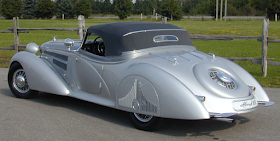"These first two cars [discussed in the article] may be considered the 'first series' cars, in that they closely resemble the [factory's] wooden model, and are virtually identical to each other. Both survive, one in Texas (Dr. Charles Key) and one in Germany (Horst Lautenschlager). "A subsequent series of cars were built (the 'second series' cars) which differed from the first in several respects. The coachwork was more modern, and featured pontoon shaped fenders and a one piece rear body (no separate fenders).
"Five of these cars were built, three of which are known to survive today. The first example was built for Nazi Herman Goering ... This first Horch 853 Special Roadster was ordered to be dismantled, although parts of the car were used in the subsequent four Special Roadsters.
"A second car remains unaccounted for, while the three surviving cars include two currently residing in Europe, and the example presented here, the Cassini car.
"The Cassini car's prewar history remains unknown, but it was imported to the U.S. in the late 1940s by a returning serviceman ..."
Below are photos of the restored 853 via the RM web site.
First, two photos taken at a Pebble Beach Concours d'Élegance.
Despite what the above quotation states, I contend the the rear fenders are essentially distinct.
This set of photos shows the car with its top raised. The design is impressive from the firewall forward -- that long, long hood with its side louvres and bits of chrome trim. The headlights seem a little too high, but the shape of the catwalk (see the first photo above) required that placement. Abaft of the firewall, things get Baroque (the rounded cockpit coaming and curved character line across the door) and even Art Deco (the decoration on the rear wheel spats).
As for the rear fenders, whereas they are distinct when viewed from the rear or quarter, it's true that the front edges are almost completely blended into the body shaping as can be seeing this image and the one above. The front fenders seem bulbous and might need a subtle character line to reduce that visual mass.
As for the car's rear, the tail lights are tiny and placed close to the thin bumper segments. The rack forward of the spare tire is placed on a lid for storage of a few travel items.
Despite my quibbles, this Erdmann & Rossi design is very impressive as well as being emotionally satisfying.





No comments:
Post a Comment